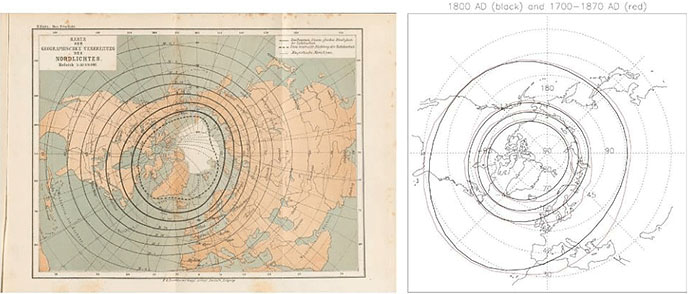Auroral activity on Earth varies over time. As the magnetic poles drift, auroras can appear at different latitudes around the globe. Solar activity also affects them, with powerful solar storms pushing the auroras further into mid-latitudes.
In an effort to better understand how auroras move around, how they'll move in the future, and when powerful solar storms might pose a threat, a team of researchers has tracked auroral activity for the last 3,000 years.
A pair of researchers associated with the National Institute of Polar Research and other institutions in Japan have used ancient literature and modern data to map the shifting auroral zone over the last three millennia. By finding historical accounts from cultures around the world they've created a video covering 3,000 years of auroral drift.
They've published their research in the Journal of Space Weather and Space Climate. The paper's title is "Auroral zone over the last 3,000 years" and the first author is Ryuho Kataoka, associate professor at the National Institute of Polar Research.
"The accurate knowledge of the auroral zone over the past 3,000 years – via worldwide old witness record of auroras, including those even from low-latitude Japan – helps us understand the extreme magnetic storms," said first author Kataoka in a press release.
Science played a role alongside ancient writings in this study. Paleomagnetism is the study of magnetic evidence in rocks, and the researchers used paleomagnetic models to map Earth's auroral zone over time.
The auroral zone is an oval shape that shifts over time. Most auroras occur in a band about 20 to 30 degrees from the poles. But that zone can stretch further into middle latitudes when powerful solar storms take place; even over regions such as Japan.
"The auroral zone changes over time, and the deformation and sporadic expansion of the auroral oval are recorded in historical documents over a thousand years from across the world," Kataoka said.

Above: On the left, a map charting auroral isochasm from 1700 to 1872. On the right, a sketch of the reconstructed auroral zone in 1800 CE and possible deformation by a 170-year integration for the time interval between 1700 CE and 1870 CE.
One of the historical documents the researchers made use of is an Old Norse text called The King's Mirror. It's 70 chapters long and is written as a dialogue between father and son. In this case, the father is Haakon IV Haakonsson and the son is Magnus Haakonsson.
The text was intended to instruct Magnus in royal affairs and prepare him for reign. It's mostly concerned with matters of the court, morality, chivalry, trade, and strategy and tactics. But The King's Mirror also contains descriptions of auroral activity over Greenland in 1200-1300 CE.
The pair of researchers also consulted a Japanese text called Nippon Kisho-Shiryo, which contains records of aurora and other phenomena. The Nippon Kisho-Shiryo has a cluster of auroras around 1200 CE, which matches what The King's Mirror shows.
In fact, in the following century, paleomagnetic data shows that the auroral zone moved away from Japan and settled over Greenland. According to first author, the historical accounts match the paleomagnetic evidence.
Paleomagnetic data shows another auroral dip over the United Kingdom during the 18th century, which also matches up with written accounts.
One of the researchers' goals was to find out if witness accounts of auroras match up with paleomagnetic data. Specifically, they wanted to see if scientific data supported the idea that the 12th century was the best time in Japan to witness auroras. They were able to confirm that, and more.
"We concluded that the 12th and 18th centuries were excellent periods for Japan and the United Kingdom, respectively, to observe auroras in the last 3,000 years," Kataoka said in a press release.
This article was originally published by Universe Today. Read the original article.



No comments:
Post a Comment